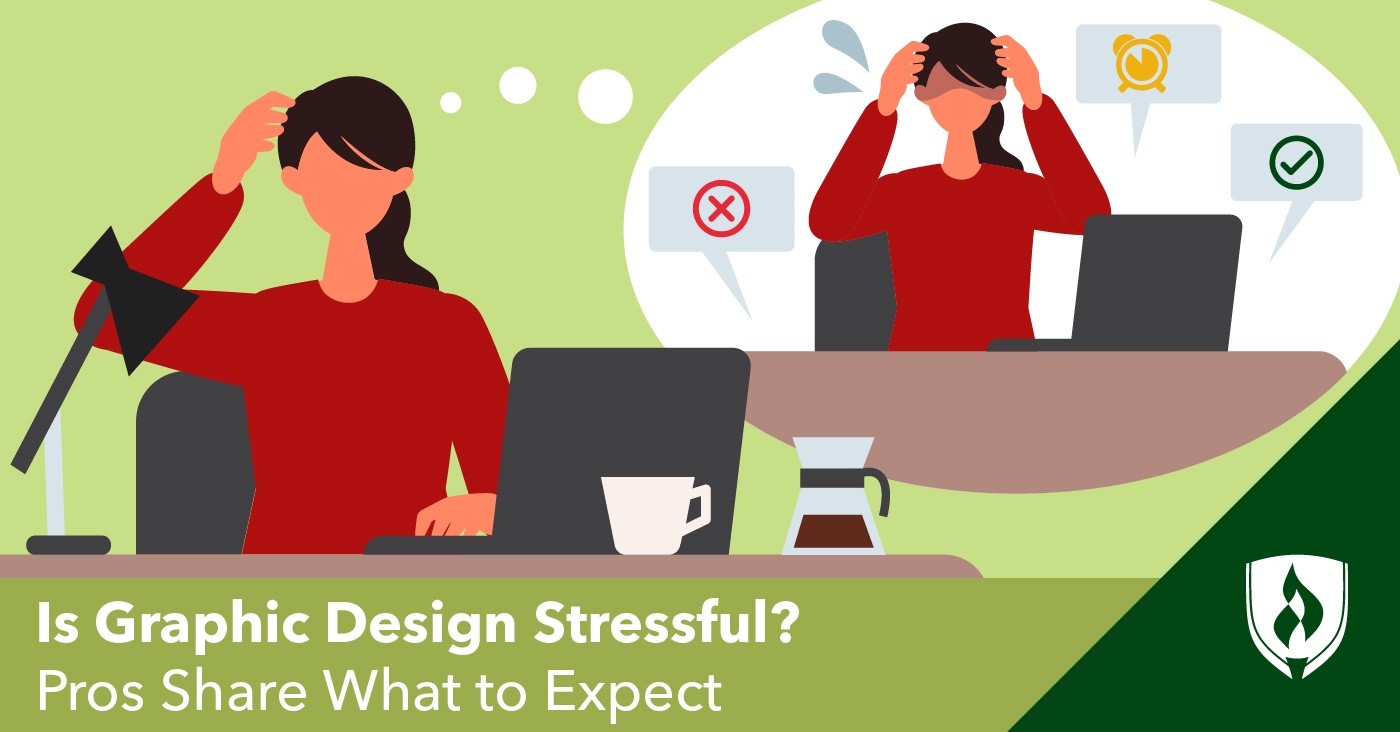
By now, you’ve probably picked up on some of the signs you could be suited for a career in graphic design. You can’t help but notice or appreciate the aesthetic details around you—like the way certain colors complement each other in an outfit or how a poor choice of layout makes certain parking-related street signs hard to understand.
You have a good sense of what works and what will draw a viewer’s attention, but before diving into the deep end of pursuing a graphic design career, you want to know more about the practical demands of the job. Does it get tense? What frustrates graphic designers? Am I going to lose sleep thinking about work? Composing visually striking creative assets seems like a genuinely cool way to make a living, but will the stress associated with it make that living rough? It’s a fair concern—and we can help shed some light on the subject.
We talked to graphic designers who have worked for companies and as freelancers and business owners to get a good grasp of the ins and outs of this work and common sources of stress.
Is graphic design stressful?
The answer to whether graphic design is stressful is ultimately subjective and will depend a lot on both your personality and the people you work with.
“Graphic design is no more stressful than any other field,” says graphic designer Ryan Mungia. “A lot of the stress depends on what kind of job you have and who you are doing it for.”
That said, there are a few common sources of stress for graphic designers:
- Keeping up with deadlines
- Navigating conflicting creative opinions
- Producing creative work on demand
As with any job, there will be busy times and tight schedules, highs and lows. Getting a sense of what a typical day involves will help you decide if the field is right for you. Freelance graphic designers and in-house graphic designers alike must handle constant deadlines, client expectations, rush jobs and varying levels of creative energy. To get a feel for whether the role will be a good match for your abilities and personality—and for ways to manage on-the-job stress—keep reading.
1. Deadlines are always present
Graphic designers are tasked to make beautiful and engaging visuals, which can be a fun process for artistic types. But these tasks are not open-ended in scope; all have deadlines and delivery dates that can put pressure on the process.
“At the end of the day, this is a deadline-focused profession,” says Bridget Soden-Mills, creative director at Creative Vortex. “Always sooner, never later.”
Soden-Mills says that while there can be some graphic design roles that are less demanding than others, the job will always have projects with tight turnarounds.
“There will always be those last-minute requests requiring late nights and weekends in the office,” she explains.
Dot Falla, lead designer at EPM Digital, agrees working on rush jobs is a common reality that can put stress on a creative’s plate.
“Being given short time restraints will always be a cause for stress,” Falla says. “It just doesn’t account for the unpredictability of creativity.”
Falla recommends graphic designers set clear goals and timelines from the start of the project whenever possible.
“Set yourself and your team an unnegotiable timeline that accounts for concept creation, idea generation, feedback rounds—internal and external—and introduce this to your client at the very beginning,” Falla says.
2. Clients and colleagues can have conflicting creative visions
Creative efforts are subjective, which means there can be clashing views about what makes a design powerful and impactful. It’s not always easy to navigate the design process when multiple important stakeholders are providing contradicting feedback—you have to learn with experience what feedback to take in, what to minimize and how to sell the final output so all are satisfied.
“That struggle to reach common creative ground is a challenge all designers face,” Mungia says. “It becomes even more difficult if you are emotionally invested in the work. These are things that become easier to manage with the more experience you have, but the first time someone rejects a design you spent a lot of time on, it can be tough.”
Budget constraints or limited scope on a project can also contribute to disagreement about what direction is best for the end result.
Will Creech, a graphic designer at Detail DIY, finds it best to check his ego in these situations.
“Often, I am too constrained to deliver the design I would be proud to deliver—but I have to do the best I can with what I have to work with,” Creech explains. “I may not be proud of the final product every time, but I can internally be satisfied with the result knowing the constraints.”
Soden-Mills echoes this advice, adding that graphic designers are not afforded the luxury of using solely their opinion.
“Successful designers are good listeners who have perfected the craft of problem-solving,” she says. “We are in the profession of creating commercial art and design, not fine art, which means we create for others with a goal and audience in mind.”
For some examples of how client feedback can cause trouble for a designer, check out our article “5 Frustratingly Common Client Feedback Examples and How to Overcome Them.”
3. Producing creatively on demand can be tricky
“One of the stressful things about being a graphic designer is constantly pumping out designs day after day with insanely high expectations and turnaround times,” says Judymae Rivera, graphic designer at ExaWeb.
Balancing work and life is an evergreen problem in any profession, but producing creative work requires some special considerations if a graphic designer wants to keep fresh and avoid burnout.
For Rivera, managing the pace of her work is easier when sticking with an established routine.
“Habits helped me prime my brain for the activities I will pursue,” she explains. “Once I have the pattern, things will become natural and subconscious. It makes it easier for me to fall into a creative and artistic state without a lot of struggle.”
Steve Kozak, creative vice president at Waste Dynamics®, believes that working for companies that understand creative flow doesn’t always conform to standard office hours can be helpful.
“Creative folks typically do not feel their most productive or creative between 9 a.m. and 5 p.m. in a cubicle setting of fluorescent lighting,” Kozak says. “Allowing designers to work in a creative, remote setting, sometimes setting their own hours, will oftentimes lead to a significant increase in productivity, creativity and overall work-life balance.”
Finding ways to refill the artistic well is also important for designers.
“A professional designer needs to refuel,” says Soden-Mills. “If they continue to deplete the creative battery day after day, there will eventually be nothing left.”
Is being a graphic designer stressful? Results may vary
Graphic design skills are applied in a variety of industries, as practically every company strives to put its best foot forward while capturing the attention and engagement of its customers. Making new eye-catching, functional and attractive designs to build or increase customer bases will always be sought after by companies. Using your natural skills and learning graphic design principles can be what drives you into the field, but understanding the on-the-ground reality of the work is also a great way to head off potential stressors.
If working with clients to achieve their creative goals sounds like it could be a good match for you, check out our article “10 Things I Wish I Knew Before Becoming a Freelance Graphic Designer.”
Waste Dynamics is a registered trademark of Waste Dynamics Holdings, LLC.




